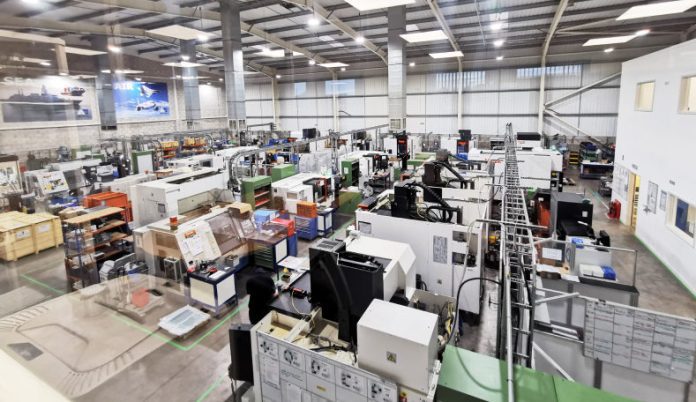AE Aerospace uses 5G manufacturing processes to optimize workflow and monetize excess production capacity
So the logic goes, enterprise buyers aren’t investing in technologies like 5G without a strong business case that reflects the impact wireless will have on operational key performance indicators, cost savings, and new revenue generation. That means the success of digital transformation will hinge on mapping technology to clear business objectives, hashing out the ability to scale from pilot to production, and selling it up to the chief financial officer. As it relates to a high-value vertical sector that operators and other ecosystem stakeholders are trying to crack, a panel discussion at the 5G Manufacturing Forum shed light on getting the business case right.
U.K.-based AE Aerospace uses a 5G network to stream data from factory implements into an analytics engine that allows them to monitor work flows to identify discrepancies between planned and actual timing and project the amount of excess production capacity. Operations Director Ian Bouquet-Taylor characterized it as part of a vision for a “glass factory” where “customers can look straight into our product line and see where their components are at any one stage.”
The idea is to optimize production timing then allow customers to purchase latent production capacity thereby letting the customer fine tune their own planning process. “Once we get very good at planning,” Bouquet-Taylor said, “we can offer that as a service so you buy the time rather than having components made a bit at a time through the process.”
As to why 5G as opposed to Wi-Fi, Bouquet-Taylor said the data volume necessary for data streaming and image transfers logjams Wi-Fi. 5G, he said, takes away concerns about overloading the network and losing reliability.
Ste Ashton, digital infrastructure and connectivity manager for the Worcestershire County Council, led a government-backed project to build a 5G network, test industrial applications and apply those learnings to the region’s manufacturing enterprises, including Worcester Bosch, Yamazaki Mazak and AE Aerospace. This gave way to nexGworx which provides professional services, including a testbed-as-a-service, to facilitate 5G system and application testing.
“We identified some clear opportunities for 5G and connected solutions to help improve productivity even in businesses that were well-tuned, lean and well-practiced in Six Sigma,” he said. Ashton and colleagues have examined use cases like preventative maintenance, automated guided vehicles, rack and storage management, pipe bending, and paint shop functions. “Some of that is pretty sexy and some of it not so sexy but it’s equally important because it’s the pragmatic, boring bits that are really important to make the big difference.”
In terms of business drivers for 5G manufacturing and related capabilities, he gave the example of Yamazaki Mazak using headsets to allow senior engineers to help technicians repair machines. The initial goal was to invest in the solution because it improved customer satisfaction. From there though, the company found that the set up reduced operational costs internally as well as the customer-facing benefit.
Ashton’s comparison of the pragmatic vs. the sexy is mirrored in how 5G manufacturing is being considered by decision makers within the sector vs. how it may be marketed by an operator or telecoms vendor. But, because of the clear line to improved business performance, it’s important to focus “one what use cases can really bridge together and connected the sort of physical and digital worlds or manufacturing, according to Deloitte Managing Director Rob Kasegrande.
Deloitte is engaged with Verizon to explore how the operator’s 5G network and mobile edge computing infrastructure can be tuned to support manufacturing and retail, and has built a facility at Wichita State University that allows prospective customers to see how the confluence of 5G, MEC and other technologies can improve manufacturing processes.
“The reality is manufacturers can’t take these all in at once,” Kasegrande said. “It’s difficult to scale without having a platform that brings together the connectivity, the data, the ability to compute the data, the devices, the AI…Manufacturers are embracing 5G as enabler of their digital transformation. But it will take some time and it will take some steps to get there. It’s not a one-size-fits-all solution.”
Zeetta Networks leads an industrial 5G project called 5G ENCODE based in Bristol, U.K., and works globally to drive adoption of 5G manufacturing solutions. Vice President of Product Management Ihab Mahna discussed the keys to moving from pilot to scale where material business value kicks in.
“The first point is collaboration,” he explained. “Collaboration is a key in all these projects. Vendors involved, service providers taking vendors equipment and either directly or indirectly provide service snd then these services need to be tailored to solve a big variety of applications. That collaboration is not just a culture. It’s also technology. The second learning to scale is also to have technology to enable agility. It’s at larger scale where you actually start understanding the requirement.”
In addition to collaboration and agility, Mahna called out the importance of developing a robust 5G manufacturing ecosystem. “Once you make a solution, it needs to be repeatable otherwise the costs would be very high. 5G is just the tip of the iceberg; 5G is just one technology but actually behind it are so many other technologies that will enable the flexibility.”
To access on-demand content from 5G Manufacturing Forum, click here.

